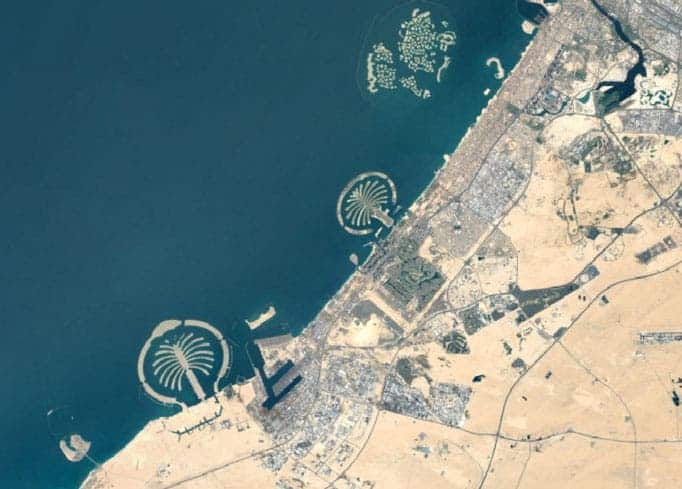
A few days ago, Google unveiled its new feature: a timelapse of the entire planet. Over 30 years of satellite data, collated into a single interactive framework on Google Earth, consisting of over 24 million photos. We’ve already covered this here, but we thought it’s worth revisiting it just to share some of our favorite captures.
While the new timelapse feature highlights many features across the world, without a doubt, the most striking theme is how mankind is affecting nature. From cities growing from virtually nothing to climate change and deforestation, here are some of our favorite Google Earth timelapses.
Cancún, Mexico
Cancún is a popular tourist destination in Mexico, and it’s been popular for a long time. But in recent years, it expanded dramatically, rising its population by over 400% in the past 30 years. It’s striking to see how the city expands and takes shape over the years.
Los Cabos, Mexico
Cancún is far from the only Mexican city to grow dramatically in the past few years. In a far less lush environment, Los Cabos grew at a comparable pace — bonus points for watching the big pools showing up.
Dubai
Of course, when it comes to cities changing the landscape, few can compete with Dubai. From the skyscrapers to the water constructions, Dubai took a desert and made it into a mega-city.
Al Jowf
It’s important to know that Dubai isn’t a singular exception — several cities followed a remarkably similar trend, with oil money funding the development of desert megacities. Al Jowf is a bit different: it focuses much more on agriculture, and you can see just how irrigation-based agriculture takes shape in the area.
Las Vegas, Nevada
The US has its own experience with making cities from nothing. Seen from above, Las Vegas looks very different from how it looks at ground level.
Chongqing, China
No compilation about city growth could be complete without a mention of China. We could add dozens of dazzling city timelapses from China, but we’ve just chosen one of the most striking ones. There are over 31 million people in the Chongqing urban area, from under 3 million in 1980.
Hanoi, Vietnam
Another country showing explosive growth is Vietnam. Hanoi has been the capital of the Socialist Republic of Vietnam since 1976, and has turned into a sprawling metropolis in recent years.
Glen Canyon, Utah
Something a bit different: a bit of nature at Glen Canyon, in Utah. You can see the canyon almost “breathing” from year to year, shifting as the influx of water increases or decreases.
Aral Sea
The drying up of the Aral Sea is perhaps the most striking timelapse here. Formerly the fourth largest lake in the world with an area of 68,000 km2 (26,300 sq mi), the Aral Sea began shrinking in the 1960s after the rivers that fed it were diverted by Soviet irrigation projects. The shrinking of the Aral Sea has been called “one of the planet’s worst environmental disasters,” bringing a once-prosperous fishing area to ruin and marking a major environmental crisis.
Solar Qinghai, China
It’s not all bad, though. The Google Earth timelapses also showcase some of the world’s most ambitious environmental projects, such as the solar farm at Qinghai, China.
Alta Wind Farm
Another such ambitious project is the Alta Wind Farm in Tehachapi Pass of the Tehachapi Mountains, in Kern County, California. As of 2013, it is the largest wind farm in the United States.
Mato Grosso, Brazil
We only get a few eco-friendly timelapses though. Mato Grosso is a state in Brazil. In the north is the biodiverse Amazonian forest, which originally covered half of the state. Much of this has been disrupted and cleared for logging, agricultural purposes and pastures.
Rondonia Brazil
Deforestation also heavily affects Rondonia. Rondonia was originally home to over 200,000 km2 of rainforest, but has become one of the most deforested places in the Amazon. By 2003 around 70,000 km2 of rainforest had been cleared.
Santistevan Bolivia
In 1992, almost half of the people in Santistevan, Bolivia, were under 16; about a third of the city didn’t have access to electricity. The city grew tremendously in the years that passed since then.
Mina Escondida, Chile
Another area heavily affected by industrial activity is a copper mine in Chile. The main orebody does not outcrop on the surface but is ‘hidden’ by hundreds of meters of practically barren overburden. The lower open pit in the satellite image on the right is the main Escondida mine, but the upper two are Barrick Gold’s Zaldívar mine.
Dairyland, California
We’ve mostly focused on recent developments, cities and areas that changed dramatically in the past 30 years, often at the expense of the nearby environment (or global emissions). But it’s important to remember that in developed places, these changes happened even longer ago.









